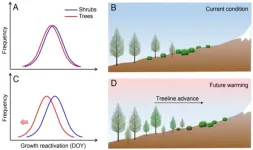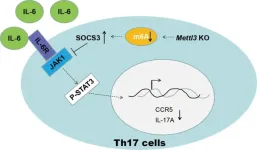(Press-News.org) The electric grids of the future will need to handle much bigger loads due to electrification of transportation and other sectors. This could mean expensive infrastructure upgrades to ensure their reliable operation, but a new study from Stanford University says most of those upgrades may be unnecessary.
Better grid reliability could be achieved instead by installing software in homes and businesses that coordinates various consumer demands and resources. Such coordination not only improves reliability of the electric grid, but also helps reduce its peak load, for example, during extreme weather conditions. The researchers say that coordination, if implemented widely, would save utility companies and their customers billions of dollars in grid infrastructure upgrades.
The study shows that, under status quo local control of demands and resources, four-in-five existing transformers will fail by 2050. Those transformers will need to be replaced, as could other infrastructure such as voltage regulators and possibly even electricity distribution lines.
“Under centralized control of the demands and resources across the grid, the number of transformer failures declines to just one in four,” said Ram Rajagopal, a professor of civil and environmental and electrical engineering at Stanford and co-senior author of the study appearing in the journal Joule. “Such dramatic reductions in future distribution grid upgrades can accelerate the rate of electrification adoption.”
Reliability matters
Electricity demand is projected to balloon over the next several decades in part because electricity is widely considered more climate-friendly than fossil fuels and because more people around the world will gain access to — or transition to — electrified heating of homes and water, air conditioning, and cooking.
Meanwhile, distributed energy resources like rooftop solar panels and residential and commercial batteries will certainly increase. So will smart appliances like electric vehicle chargers, electric space and water heaters, and air conditioners, whose power usage can be controlled to reduce consumer costs and total power system demand. That is, when connected through the Internet of Things, the operations of millions of these next-generation devices can be coordinated.
“The team decided to look at how much coordination of distributed energy resources and smart appliances can help grid reliability,” said Abbas El Gamal, a co-senior author of the study who is a professor of electrical engineering and senior fellow of the Precourt Institute. “We found that the benefits of coordination can be very significant using nothing but software. No new infrastructure. No replacements of distribution lines. It can all be done using existing computer clouds.”
Today, appliances and energy resources within each home or business are operated more or less independently. Each consumer makes choices about their heating and cooling, storage of excess solar generation, as well as charging electrical vehicles based mostly on personal need. That is to say, today there is not much coordination of such resources across different consumers. Present day approaches prioritize lowering consumer’s electricity costs over grid reliability, but there is a trade-off. Declining reliability can increase the cost of electricity, too, as failing transformers and other infrastructure must be upgraded.
Pleasant surprises
No one to date has gone to the lengths of this study to understand and quantify that trade-off, because it’s not easy to do. The team used models of distribution networks of varying sizes, mixes of homes and businesses, and from a range of climates across the United States. They then applied recent projections of increases in electrification and distributed energy resources and their adoption scenarios up to the year 2050.
“We developed our methodology over several years. We were conservative in our assumptions and our estimates,” said Thomas Navidi, lead student author of the paper, who will soon finish his PhD in electrical engineering. Navidi spent much of the last two years on the nuts and bolts of the simulations and experiments.
“One key finding that caught our attention was how valuable coordinating thermal loads is to our findings. It was very significant, even more so than battery storage and flexible scheduling of EV charging,” Navidi said, explaining that these loads include everything that uses electricity to raise or lower temperatures, from cooling or heating a home to making aluminum. “We are also making our software publicly available so anyone can calculate the potential benefits of coordination to their grids with their own assumptions.”
In addition to improved reliability, the team also found that coordination can reduce peak load on the distribution grid by some 17 percent, which has the added benefit of reducing electricity costs during extreme climate conditions.
Next steps include developing a coordination scheme that would work across large numbers of homes and businesses, rolling out a pilot, and then — if the pilot works — developing a broader rollout that would include incentives to consumers to install the necessary software to achieve critical mass of adoption that could reap considerable rewards.
“In light of these savings and benefits, we think our software-only coordination approach deserves attention,” said El Gamal. “It could save billions.”
This research was funded by the U.S. Department of Energy, as well as by the department’s Advanced Research Projects Agency-Energy (ARPA-E).
END
Coordination could spare billions in grid upgrade costs and accelerate electrification
2023-07-14
ELSE PRESS RELEASES FROM THIS DATE:
Conditional cash transfer programs have prevented 739,919 child deaths in Latin America
2023-07-14
Over the past two decades, conditional cash transfer programmes have led to a 24% reduction in child mortality in Brazil, Mexico and Ecuador, equivalent to more than 700,000 child deaths averted, according to an impact evaluation study led by the Barcelona Institute for Global Health (ISGlobal), an institution supported by “la Caixa” Foundation. The results, published in JAMA Network Open, also show that expanding these programmes could save more than 150,ooo lives by mitigating the effects of the ...
Neighborhood racial segregation linked to shorter life spans by four years
2023-07-14
New nationwide study is first to examine implications of racial segregation on life expectancy by neighborhood
Findings quantify how neighborhood segregation contributes to racial inequities in life expectancy
Black residents living in heavily segregated areas experienced higher rates of poverty and unemployment and less education
CHICAGO --- Black residents living in highly segregated neighborhoods have significantly shortened life expectancies, reports a new Northwestern Medicine study.
Compared to residents living in less segregated predominantly ...
Fintetuning for antibodies
2023-07-14
Antibodies are crucial, not only for treating tumors and infections. Sometimes, however, the immune reaction they trigger can be too strong and end up causing more damage, for example in the case of people infected with Covid-19. Problems such as these can often be avoided by finetuning antibodies, as Prof. Dr. Falk Nimmerjahn from Friedrich-Alexander-Universität Erlangen-Nürnberg (FAU) and two of his colleagues in the Netherlands and in the UK have now reported in the journal Nature Immunology.
In his laboratories, the FAU researcher is carrying out research into immunoglobulin ...
Single-end hybrid Rayleigh Brillouin and Raman distributed fibre-optic sensing system
2023-07-14
The real-time monitoring of facilities, particularly large facilities (such as rail transit systems, large bridges, and buildings), can provide information regarding their surrounding environment and allow their health conditions to be assessed, which is essential for establishing the current concept of smart cities based on the Internet of Things. As a precise real-time monitoring technique, distributed fiber-optic sensing (DFOS) systems, which require long-distance simultaneous measurements along a sensing fiber, are in high demand for various industrial applications. However, ...
Why trees outcompete shrubs to shift upward?
2023-07-14
The findings from this study, led by Professor Eryuan Liang (Institute of Tibetan Plateau Research, Chinese Academy of Sciences), were published as a research article in the journal National Science Review. The study also involved researchers from, CREAF, CSIC, Global Ecology Unit CREAF-CSIC-UAB, Instituto Pirenaico de Ecología (IPE-CSIC), Spain and Université du Québec à Chicoutimi, Canada.
Climatic warming is altering the structure and function of alpine ecosystems, including shifts of vegetation boundaries. The upward shift of alpine treelines, the uppermost limit of tree growth forming the boundary between montane forest and alpine communities, ...
New fossil flying reptile ‘Elvis’ takes flight
2023-07-14
A new 145-million-year-old pterosaur (extinct flying reptiles that lived alongside the dinosaurs) was named today by a team of British, American and German researchers. The animal was nicknamed ‘Elvis’ when the fossil was first unearthed in Bavaria, Germany because of the giant pompadour-like bony crest on its skull.
Now the animal has been given a formal scientific name of Petrodactyle wellnhoferi. The name translates as ‘Wellnhofer’s stone-finger’ honouring legendary German palaeontologist ...
m6A mRNA modification potentiates Th17 functions to inflame autoimmunity
2023-07-14
N6-methyladenosine (m6A) is the most extensive studied RNA modification across various species, and the important effect of m6A modification in immune system has been revealed in distinct contexts, including mRNA metabolism, cell differentiation, proliferation and response to stimulation. Previous studies from Hua-Bing Li group demonstrated that m6A methyltransferase METTL3 control T cells homeostasis and sustain the suppressive function of regulatory T cells (Tregs). However, the role of m6A methyltransferase in other subtype of T cells remains unknown.
T helper cells 17 ...
Exercise during dialysis has positive health impact
2023-07-14
Patients who engage in light exercise while undergoing dialysis are physically fitter and are admitted to hospital less frequently than those who do not. These are the findings of a large-scale study conducted by a consortium led by the Technical University of Munich (TUM). The researchers believe that exercise programs should be offered to dialysis patients as standard.
Around 558,000 people in the United States have such severely impaired kidney function that they require dialysis several times per week. In Germany, about 80,000 people regularly undergo ...
Link between oropharyngeal cancer and sexual behavior
2023-07-14
Human papillomavirus (HPV) is a ubiquitous virus, and most people are infected at some point in their lives. HPV can infect epithelial cells of the skin and mucosa at various sites. There are more than 100 known HPV subtypes, most of which cause only benign lesions such as warts and condyloma. Thanks to a well-functioning immune response, most people who are infected don’t develop serious symptoms. However, some HPV subtypes are not so harmless. These subtypes, and especially subtype HPV16, can transform infected cells to become neoplastic, and these malignant transformed cells then develop into precancerous ...
Scientists use Insilico Medicine’s generative AI platform to predict drug targets for rare lysosomal storage disease
2023-07-14
A team led by researchers at the Mechanisms of Inherited Kidney Disorders (MIKADO) group at the University of Zurich (Zurich, Switzerland) has used Insilico Medicine’s generative artificial intelligence (AI) target discovery engine, PandaOmics, to identify actionable drug targets for the lysosomal storage disease cystinosis and to validate them in preclinical models of the disease. These results, which open new therapeutic possibilities for this devastating disease, were published June 14 in the journal Nature Communications. Collaborators include scientists from Microsoft Research-University of Trento Centre for Computational ...






